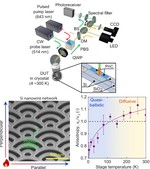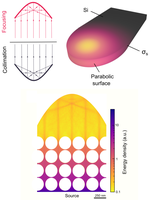Ray phononics
 Simulation of heat focusing effect
Simulation of heat focusing effect
In phononics – the science of phonons – researchers invent and develop micro- and nanostructures that can manipulate phonon motion. In nanostructures called phononic crystals, similarly to photonic crystals, phonons reflect from periodic boundaries and generate wave interference, which can guide phonons in certain directions. For such interference to occur, phonons must preserve their phase after scattering from the boundaries, for which phonon wavelength must by far exceed the surface roughness. While this condition is usually satisfied for mechanical waves and sound, phonons that carry heat have wavelengths of a few nanometers and cannot preserve their phase after multiple reflections. Thus, classical phononic structures cannot effectively control heat conduction via phonon wave interference.
However, in our recent experiments and simulations, we found that phononic crystals can still control directions of heat fluxes but using particle instead of wave properties of phonons. Indeed, in crystals phonons can exhibit particle-like behavior and ballistically travel in straight lines for hundreds of nanometers between diffuse scattering events. As diffuse scattering randomizes the direction of the next phonon flight, we can design nanostructures with specific boundaries to maximize the probability of phonon transport in certain directions. Thus, using ballistic phonon motion and nanostructuring we can shape the overall phonon flux and engineer heat transport. We call this concept of heat flux manipulation “ray-phononics” to contrast with classical wave-based phononics.

This approach enables various devices capable of heat flux control. Figure above shows examples of such devices. The first device is the emitter of heat rays (a). In the emitter, all direct passages but one are blocked, thus enabling the emission of a single ray in a given direction. This ability of creating heat fluxes in desired directions and at the desired locations lies at the foundation of all other devices. For example, in the thermal shield device (b), holes are arranged so as to guide the heat around the protected region. Thus, when the passages between holes become narrow, the protected region feels no external gradient and has a flat thermal map. Conversely, if the holes are arranged to guide several heat fluxes into the same spot, the device can focus heat (c). Also, these fluxes can be used for more conventional applications such as creating temperature gradients for thermoelectric generation (d). Finally, panel (e) shows an example of a thermal long-pass filter that uses the created heat ray and the fact that low-frequency phonons are more likely to reflect elastically from rough surfaces.
The project was started under the JSPS postdoctoral schilarship (2016-2018) and is curently continued under PRESTO JSP research grant (2019-2021).





